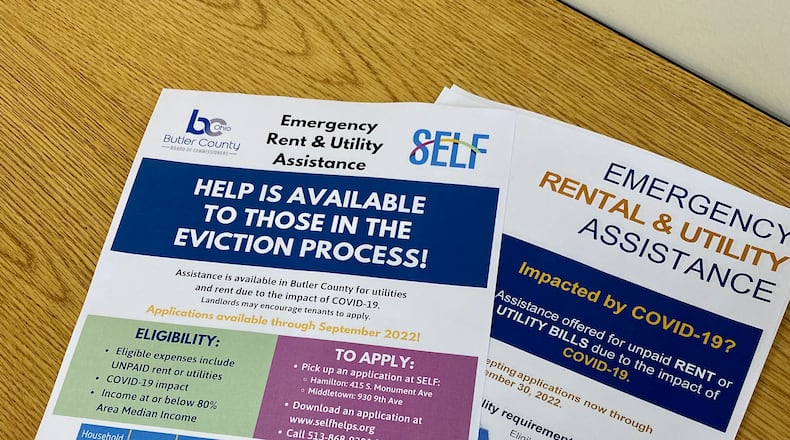Diver told the Journal-News the need for relief hasn’t diminished for many despite the easing of the pandemic. The agency had a backlog of 350 applications and was forced to pause accepting new clients in the beginning of August.
“There are still individuals that are getting COVID, for those individuals that may have gotten COVID in the last year, they’re still behind on the their bills, still struggling to make ends meet,” Diver said. “Those issues are still very prevalent today. COVID is still very much impacting the lives of low-income families.”
There are restrictions on the money, such as that recipients must be able to demonstrate their inability to pay their rent is due to COVID-19. Eligible renters must make below 80% of the area median income, or about $45,000 for a family of two.
In response to the coronavirus pandemic, federal lawmakers approved two emergency rental assistance programs, the first bucket of up to $25 billion was established under the Consolidated Appropriations Act of 2021, which was enacted in December 2020. Butler County qualified for $11.4 million under that program, and Diver said they have spend all of that money.
Another $21.5 billion was approved under the American Rescue Plan Act which was enacted in March 2021. The county commissioners were allotted $9 million but did not accept the second round of funding initially because they wanted to gauge the need first. They tapped it in January.
Diver said the federal government still owes the county about $5.4 million. The county’s Development Director David Fehr said they received the entire $11.4 million at once in the first round, but the U.S. Treasury only released 40% — $3.6 million — of the second funding batch. His office has been calling Washington D.C. weekly since the beginning of August trying to find out when the rest of the money will arrive.
“I don’t know what the rationale is for that, I know they wanted to make sure communities were spending the money as promptly as possible, I felt like we did a very good job, we got all of that round one money expended in a responsible manner,” Fehr said. “It’s been a little frustrating on our end. We’re in the dark as much as everybody on this.”
Diver said they have whittled the backlog down to about 75 applications but are being cautious about accepting new applications until they know if or when the federal money is coming. He is hoping to resume the program shortly but there is another hitch. They have access to another $3.6 million in state funds but it must be used by the end of September.
“But that’s not money we’ve been given, unlike with the county money, we draw on that,” Diver said. “The money we’re getting from the state we have to get reimbursed for it. So since we don’t really have that money it’s not like we’re losing it, it’s not money we ever had.”
The Journal-News reached out to the U.S. Treasury but there was no response. A report on its website indicates $20.9 billion of the $25 billion first round of funding had been expended as of the end of June. The deadline is the end of this month.
For round two, $11.3 billion of the $21.5 billion has been spent.
Of those dollars, $1.87 billion has been on administration fees, local jurisdictions were allowed to keep 15% of the money managing the programs. SELF is only collecting a 10% administration fee or $1.25 million thus far. Of that amount, $59,500 has gone to the five partner agencies Diver enlisted to help with the program.
SELF has been working with the Butler County Educational Service Center, Family Promise, the Family Resource Center in Oxford, the Islamic Educational Council and Reach out Lakota to help spread the word and get eligible residents processed for their assistance.
Fehr said they negotiated the administration fee with Diver and his department — which is overseeing the program for the county — is not taking any fees.
“We wanted to make sure we’re getting the money in the hands of those that need it,” Fehr said. “And that we’re not going to have administrative costs eat into that and Jeff felt that he could do the program for that amount of administrative fees.”
When the commissioners approved the first allocation of money they wanted assurance landlords wouldn’t evict the people — the federal government placed a moratorium on evictions during the height of the crisis — after they got their money or raise rent; they wanted to utilize wrap-around programs the county has to help people get back on their feet, and they wanted to make sure people understood this is short-term assistance.
Brandon Beard told the Journal-News he received about $14,000 from SELF, paying his rent for seven months and “it was a big sigh of relief.” His temporary construction job ended and his $10-per-hour Kohls pay didn’t cover expenses for his family of four. His landlord told him about SELF and took him off the eviction list. But they aren’t out of the woods yet. Beard, who is now working at Honeywell, won’t ask SELF for help a third time.
“It’s a struggle because I got a newborn at home and I’m paying like $1,400 a month for daycare,” Beard said. “I’ve been looking for a second job so I don’t know what I’ll do.”
The eviction moratorium was a moving target since it was instituted in March 2020 as part of the federal CARES Act, deadlines to end the ban kept moving but the highest court in the country had the last word a year ago.
Eviction cases in the Area Courts and municipal courts in Hamilton and Middletown totaled 4,316 pre-pandemic, dropped to 3,096 in 2020 and jumped slightly last year to 3,189. As of the end of August there were 2,363 cases, breaking that down there were on average 265 cases a month filed last year compared to 295 this year.
A couple months ago Diver told the Journal-News there was a “perfect storm of increasing, fuel prices, increasing rents and increasing food prices, those are all putting a squeeze on the lowest income households.”
Today he says that storm seems to be subsiding a bit.
“We’ve heard the rents are moderating, they’re not growing as much as they were growing,” Diver said. “And one thing to remember with evictions there are a lot of reasons a person gets evicted, non-payment is one of them but there could be other reasons for evictions in terms of violating the lease.”
About the Author

